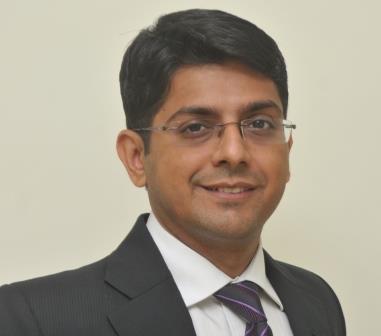
Amit Ganatra has over 16 years’ experience in equity research and currently serves as the Fund Manager – Equities at Invesco Asset Management (India) Private Limited. Amit holds a Commerce degree and is a Charted Accountant. He is also a Chartered Financial Analyst from AIMR.
He is currently managing Invesco India large cap fund, Invesco India growth opportunities fund and Invesco India Tax plan. All these funds are recommended by Geojit.
In this exclusive interview with Geojit Insights, Amit Ganatra talks about how they pick stocks and deliver returns.
In her maiden budget, the Finance Minister Nirmala Sitaraman suggested increasing the Minimum Public Shareholding (MPS) from 25 %to 35%. This can create a flood of new papers worth around Rs.3.5 lakh crores coming into the equity markets. If the supply of shares increases suddenly, it may impact the valuation of these shares. In your portfolio there are some stocks like Bharathi Airtel, TCS etc., where promoter’s holdings are more than 65%. How will this move impact your portfolio?
While short term movement in stock prices can be because of number of factors such as news flow, ownership changes etc, long term value creation is driven by factors such as earnings and valuations. Hence good quality businesses, which create wealth through compounding of earnings and are trading at attractive valuations would always find demand for any change of supply.
The recent budget has given more emphasis to Electric Vehicles (EVs), where there was a reduction on GST for EVs from 12% to 5% and an additional Rs.1.5 lakhs deduction on income tax for the interest on loan taken for EVs. How will this move impact the auto sector? What is your outlook on the auto sector for a medium term perspective?
Eventual shift from IC Engines to EV looks promising in the long run (8-10 years). However the pace of transitioning would depend on a number of factors such as product prices and charging infrastructure. Since the change in both these factors are only gradual; the transitioning also will be incremental in nature. As of now EV technology is globally in an evolution phase and enjoys a very small market share. So at this stage of product prices and charging infra structure in India, EV’s cannot pose a big threat to IC engines. However Indian OEMs, like their global counter parts, are incrementally focusing on EVs and with time may roll out products at affordable prices.
In recent times we have seen that the pharma sector go through a tough phase. You are holding some pharma companies in your portfolio. What is your outlook on the pharma sector? Can investors expect same return as during 2013-15 in the near future?
In the pharma sector, each company has its own risk reward and hence one cannot take a top down view. Our pharma companies’ exposure is because of bottom up investment rationale in these companies and not with an expectation of repeat of 2013-15 cycle. At current stage most of the companies in this sector are the bottom of the cycle earnings as well as valuations. So if one is able to build an investment rationale for turnaround of earnings, then risk-reward may be attractive.
Finance Minister announced bringing exchange-traded funds investing in central public sector enterprises (CPSE ETFs) in line with the Equity Linked Saving Scheme (ELSS) to encourage long term investment in CPSEs. What is your view on this?
Any incentive to encourage savings is always good for investors. However, as far as State owned entities are concerned, Government should remember that ultimate value creation would be dependent on pace of reforms pertaining to their capital structure, governance, employees, capital allocation policies and independence of boards and not on tax breaks. Hence, providing tax breaks can only be an additional incentive and not the core incentive of investing in CPSE ETF’s.
What is the margin of safety you look in a stock? Do you have your own way to calculate it?
Margin of safety in a stock is the downside that one can face if investment argument goes wrong. While Earnings multiple is the simplest way to understand overvaluation, undervaluation and determine margin of safety, we also use a reverse discounted cash flow model to understand the implied growth build into the stock price. So if implied growth is significantly higher than what the company has delivered in the past and is capable of delivering, then scope of disappointment is higher and hence margin of safety is low and vice versa.
Should Indian equity investors reduce their return expectations from 12-15% CAGR, especially when the inflation has come down to 2.5-3.5 % range and the market is showing liquidity crunch?
Long-term returns of any asset class are a spread over inflation with equities generally having the highest spread. So if long-term inflation in India has come down from double digit to low single digit, even if spread over inflation remains same, nominal returns would be lower due to lower inflation.
What are the asset allocation strategies you follow in the Equity Savings Fund? Can it be an alternative for the conservative hybrid funds for an investor who wishes to have a small allocation in equity?
The Invesco India Equity Savings Fund follows a three-pronged investment strategy combining equity, fixed income and arbitrage for income generation. The pure equity (unhedged) exposure is maintained between 15% – 40% of net assets. The fund also pursues arbitrage opportunities in the range of 25% – 75% and a further, 10% – 35% is allocated to debt and money market instruments. The pure equity exposure is aimed at generating capital appreciation, while arbitrage opportunities and allocation to debt securities is directed towards generating income. Conservative investors can consider Invesco India Equity Savings Fund as an alternative, which can offer controlled exposure to equity along with the characteristics of traditional investments.
In recent times, we have seen some stocks going down by over 90% from their all-time highs which makes it difficult for a common investor to select stocks for his long term investments. What are the strategies you follow to identify such risky stocks and the risk measures you adopt to avoid such stocks from your portfolio?
At Invesco Mutual Fund, we follow our proprietary investment process, which is further supported by our stock categorization process. The objective of our stock categorization process is to enable us to identify stocks that are likely to be the best investments from within our universe. Each category of stock has a description of fundamental attributes that we expect the company to possess and is then uniquely categorized. The fund manager can only invest in companies, which have been categorized. This process enables the fund managers at Invesco Mutual Fund to focus on the fundamental attributes that drive stock price performance and keep a watch on red flags.
Is it the right time to enter into mid cap category?
If you exclude the loss making midcap companies from Nifty Midcap 100, the index is trading at 22% discount to its 13-year average. However, while valuations are getting reasonable you need to be selective and identify high quality businesses with sound fundamentals that trade at attractive valuations.










